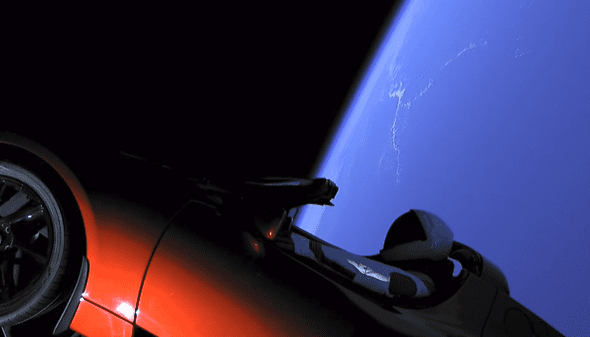Watch: Elon Musk sends his car to Mars … sort of
Video of the launch and current live stream available at the bottom of the post
SpaceX has scheduled the first Falcon Heavy launch for Tuesday the goal of which is to put CEO Elon Musk‘s midnight-cherry red Tesla Roadster in an orbit going between Earth and Mars repeatedly.
The Falcon Heavy launch would place the Roadster into a heliocentric orbit, meaning that like the planets and comets and so on, it will be orbiting the sun. More specifically, the Muskmobile will go into a type of heliocentric orbit called Trans-Mars injection, which is the easiest and least energy-intensive way to move objects back and forth between Earth and Mars.
In anticipation of a successful launch, SpaceX released an animation set to Bowie’s “Life on Mars” showing the launch, booster separation and return and the Roadster’s entry into Mars orbit.
When Falcon Heavy lifts off, originally scheduled for 1:30 p.m. EST, it will be the most powerful operational rocket in the world by a factor of two. With the ability to lift into orbit nearly 64 metric tons (141,000 lb)—a mass greater than a 737 jetliner loaded with passengers, crew, luggage and fuel–Falcon Heavy can lift more than twice the payload of the next closest operational vehicle, the Delta IV Heavy, at one-third the cost.
Falcon Heavy’s first stage is composed of three Falcon 9 nine-engine cores whose 27 Merlin engines together generate more than 5 million pounds of thrust at liftoff, equal to approximately eighteen 747 aircraft.
Following liftoff, the two side boosters separate from the center core and return to landing sites for future reuse. The center core, traveling further and faster than the side boosters, also returns for reuse, but lands on a drone ship located in the Atlantic Ocean.
For this test flight, Falcon Heavy’s two side cores are both flight-proven. One launched the Thaicom 8 satellite in May 2016 and the other supported the CRS-9 mission in July 2016. SpaceX will attempt to land all three of Falcon Heavy’s first stage cores during this test. Following booster separation, Falcon Heavy’s two side cores will attempt to land at SpaceX’s Landing Zones 1 and 2 (LZ-1 and LZ-2) at Cape Canaveral Air Force Station, Florida. Falcon Heavy’s center core will attempt to land on the “Of Course I Still Love You” droneship, which will be stationed in the Atlantic Ocean.
At max velocity, the Roadster will travel 11 km/s (7mi/s) and travel 400 million km (250 million mi) from Earth.
Musk has kept expectations low for the maiden launch of the Falcon Heavy saying that it could just blow up.
“It will be a really huge downer if it blows up but hopefully, if something goes wrong, it goes wrong far into the mission so we at least learn something along the way,” Musk said.
Whether successful or catastrophic, the launch will be one for the ages.
“I am sure we have done everything we could do to maximize the chances of success for this mission,” Musk said Monday during a prelaunch news conference. “Once you have done everything you can think of, if it still goes wrong, there is not much more you could have done. I feel at peace with that.”
Mission Timeline (all times approximate)
COUNTDOWN
Hour/Min/Sec Events
– 01:28:00 SpaceX Launch Director verifies go for propellant load
– 01:25:00 RP-1 (rocket grade kerosene) loading underway
– 00:45:00 LOX (liquid oxygen) loading underway
– 00:07:00 Falcon Heavy begins engine chill prior to launch
– 00:01:00 Flight computer commanded to begin final prelaunch checks
– 00:01:00 Propellant tank pressurization to flight pressure begins
– 00:00:45 SpaceX Launch Director verifies go for launch
– 00:00:05 Engine controller commands side booster engine ignition sequence to start
– 00:00:03 Engine controller commands center core engine ignition sequence to start
– 00:00:00 Falcon Heavy liftoff
LAUNCH, LANDINGS AND ORBITAL INSERTION
Hour/Min/Sec Events
00:01:06 Max Q (moment of peak mechanical stress on the rocket)
00:02:29 Booster engine cutoff (BECO)
00:02:33 Side cores separate from center core
00:02:50 Side cores begin boostback burn
00:03:04 Center core engine shutdown/main engine cutoff (MECO)
00:03:07 Center core and 2nd stage separate
00:03:15 2nd stage engine starts
00:03:24 Center core begins boostback burn
00:03:49 Fairing deployment
00:06:41 Side cores begin entry burn
00:06:47 Center core begins entry burn
00:07:58 Side core landings
00:08:19 Center core landing
00:08:31 2nd stage engine cutoff (SECO-1)
00:28:22 2nd stage engine restarts
00:28:52 2nd stage engine cutoff (SECO-2)
Mission continues on an experimental long coast and third stage two burn to
target a precessing Earth-Mars elliptical orbit around the sun
Launch Video
The launch has been moved to 3:30 p.m. EST due to upper-level wind shear. If the launch does not occur by 4:00 p.m. EST, it will be postponed until Wednesday during a launch window from 1:30 p.m. to 4:00 p.m. EST.
Current Live Stream of second stage headed for trans mars injection orbit
More Falcon Heavy (BFR) videos
The Falcon Heavy is a stepping stone to the BFR, the Big F’in Rocket, planned for mid 2020 launch which is expected to take people and supplies to Mars and back.




